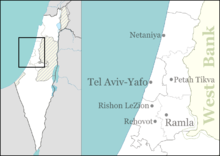|
Ayalon Cave
The Ayalon Cave (Hebrew: מערת איילון, Arabic/Aramaic, Shiha شيحا) is a large limestone cave near Ramla, Israel, with a worldwide unique ecosystem. As photosynthesis is not possible inside the completely dark cave, the food chain that developed inside is solely based on bacteria capable of chemosynthesis: the bacteria are consuming the anorganic matter available in the groundwater, and then themselves become the organic food source for the rest of the food chain. As of 2021, Ayalon Cave was one of less than 10 such subterranean ecosystems known in the world, with each of them being distinctly different from the rest.[1] Eight new invertebrate species were discovered there in April 2006 - four seawater and freshwater crustaceans along with four terrestrial animals, one of them a species of blind scorpion – with many more expected to be discovered.[2] Discovery and descriptionAccording to historian Roy Marom, the existence of significant caves on the site was known to the ancients. In the 16th century, the site is recorded as Mazraʽat šīḥah /Mazraʽat šīḥa/ [54], “the farm of the pit, cavity, ditch”, from Aramaic šyḥ’, exemplifiying and motivated by the fact that the site has dozens of caves and underground caverns. In the 19th century, the site was known as muġur šīḥa ("Shiha Caves").[3] The cave was rediscovered in 2006 when a small opening was discerned in the quarry.[4] The cave, 100 metres (330 ft) deep, extends 2,700 metres (8,900 ft) including its branches, which makes it the third-largest limestone cave in Israel.[5] SignificanceAccording to Professor Amos Frumkin of the Hebrew University, the cave is unique in that a thick layer of limestone left it impermeable to any water coming from the surface. It has been studied for its complex food web, which survived for millions of years without light or organic food coming in from the surface, being based solely on a type of bacterium which feeds on sulfur which serves as the only organic matter available for the next higher level of organisms to feed on. The cave has offered an ecological refuge for species whose relatives living at the surface have been wiped out by climatic changes and catastrophic events over millions of years, and offers a unique sample for the study of long-term ecological changes in the area.[5] EcosystemPhotosynthesis-free food chainAs the cave was completely cut off from the outside environment, it sustained an independent ecosystem; this ecosystem relied for an energy source neither on sunlight and photosynthesis, nor on an external source of organic compounds. Rather, energy was extracted by chemoautotrophic bacteria, living in a film on top of the water of an underground lake. These bacteria produce energy by oxidizing the sulfide compounds in the water, and derive organic compounds using carbon dioxide from the air. These compounds form the basis of the cave's ecosystem. The temperature and salt content of the cave's water indicates that it originates from sources deep underground. Although this cave is part of an aquifer fed by rain falling in the mountains to the east, which happens to be one of the main potable water sources for Israel and the Palestinian territories, chemically more complex sources can create local pockets with very specific water composition.[citation needed] New speciesResearchers announced that they had discovered eight species previously unknown to science, all without eyes, comprising four aquatic crustacean species and four other species of terrestrial crustaceans and springtails.[5] A species of eyeless troglobitic scorpion representing an unknown taxonomic family was discovered only a decade or so after its extinction. This was probably caused by overpumping of the ground water, which has led the underground lake to shrink, and with it the food supply to dwindle. The ten specimen found dead in the cave are exceptionally well preserved and allowed the conclusion that they used a motion detecting organ situated on their abdomen for orientation. The species was given the name Akrav israchanani, from the Hebrew word for scorpion, "akrav", and honouring the researchers who identified it, Israel Naaman and Hanan Dimentman.[5] 2021 destruction threat avertedThe cave is located on the premises of a limestone quarry owned by the cement manufacturing Nesher Industries.[1] As of 2021, a new railway line required that the Ayalon River valley be narrowed, and the National Infrastructure Committee together with the Water Authority were planning to divert runoff water in winter so as to avoid flooding by the Ayalon River, the quarry with the Ayalon Cave having been proposed as a possible catchment pool.[1] Various scientists and the Israel Nature and Parks Authority have been opposed to the idea, with an online public signature collection supporting their position.[1] Scientists argued that a massive influx of surface runoff water, which is totally different from the groundwater on which the unique cave ecosystem is based, would be sure to destroy it.[1] The intervention by Israeli and foreign researchers and the public petition has saved the cave's ecosystem, the authorities deciding for a different technical solution.[6] AccessThe cave is not accessible to the public. Only a small number of researchers are allowed to enter.[5] See also
References
External linksWikimedia Commons has media related to Ayalon Cave.
|
||||||||||||||||||

